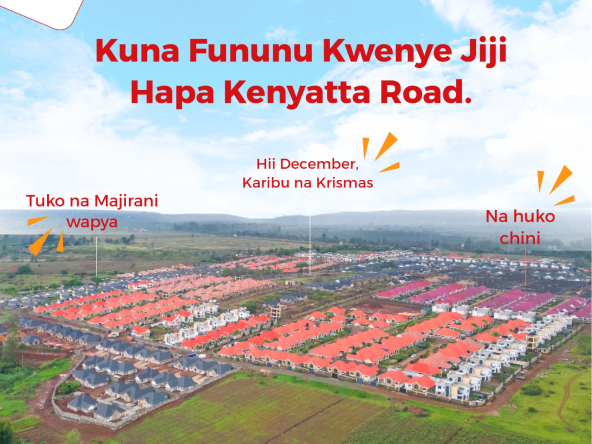In recent years, Kiambu real estate development has transformed the county’s once-pastoral landscape into a patchwork of gated communities, apartment blocks, and commercial centers. What was formerly the green lung of Nairobi — a bastion of tea farms, dairy projects, and horticultural estates — is increasingly giving way to tarmac, tiles, and towers. This tension between agriculture and real estate is no longer a theoretical debate but a physical one — with bulldozers literally plowing through farmland to make room for foundations.
From Green to Grey: What the Data Shows
Kiambu County has long been a major agricultural hub in Kenya, thanks to its proximity to Nairobi and its fertile, well-watered soils. According to the Kenya National Bureau of Statistics (KNBS), agriculture employs over 60% of Kiambu’s rural population. But this trend is changing. A 2019 report by the Ministry of Lands revealed that land under active farming in Kiambu has declined by nearly 22% over the past decade, with the steepest drops occurring in areas like Ruiru, Juja, and Kikuyu.
Simultaneously, real estate prices have soared. In places like Kamiti Road, a 50×100 plot that went for KSh 350,000 in 2010 now fetches over KSh 2.5 million. The economic logic for landowners is obvious — why wait for cows to mature or tomatoes to ripen when a single transaction can yield instant millions?
Read Also: How Diaspora Housing Saccos Are Reinventing Collective Investment in Kenya
The Agribusiness Sector Sounds the Alarm
Farmers and agribusiness investors are raising red flags. “The ripple effect is severe,” says Mureithi Gachanja, a Kiambu-based agronomist. “As productive land shrinks, food insecurity creeps in — not just for Nairobi, but for the region. What used to be a breadbasket is becoming a real estate brochure.”
In fact, Kiambu supplies a significant portion of Nairobi’s fresh produce, including vegetables, milk, and eggs. The loss of arable land to housing developments means more reliance on imports from far-flung counties like Nyandarua and Meru — increasing transport costs and food prices in the capital.
The Allure of Proximity: Why Developers Are Targeting Kiambu
The demand is driven by Nairobi’s expanding middle class and the capital’s increasingly unaffordable housing market. Kiambu offers a rare combination: it’s close to Nairobi’s CBD, enjoys cooler climates, and has a road network that’s been vastly improved in the past decade — notably with the Eastern Bypass, Northern Bypass, and Thika Superhighway.
Private developers are targeting once-rural zones to construct affordable housing estates, apartment complexes, and even malls. The trend is often fueled by speculative buyers who bank on future infrastructure developments to push up land value — sometimes with little regard for zoning or sustainability.
Legal Gray Areas and Weak Zoning Policies
At the heart of the problem lies Kenya’s inconsistent and weakly enforced zoning laws. Despite Kiambu County having a County Spatial Plan (2015-2025), enforcement remains patchy. Land previously designated for agriculture can be reclassified as residential with little public consultation, opening the floodgates for conversions.
The National Land Commission and Kiambu County Government have acknowledged the challenge but often lack the resources — or political will — to act decisively. Some developers even begin construction before approvals, knowing they can “regularize” their projects later through backdoor negotiations.
Can a Middle Ground Be Found?
Some experts are calling for integrated land use models that balance urbanization with food security. These include:
- Agri-estates: Housing projects that incorporate green zones and smallholder farming plots.
- Green zoning overlays: Regulatory tools that preserve high-yield agricultural zones.
- Vertical farming incentives: Encouraging urban agriculture and rooftop farms in estates.
- Developer taxes for food loss: A form of impact assessment levy for major residential builds on agricultural land.
Kenya can also borrow from models used in countries like the Netherlands and Japan, where land is scarce but farming is protected through policy, technology, and vertical land-use planning.
Cultural Loss: More Than Just Soil
The impact isn’t only economic — it’s also cultural. For many families in Kiambu, farming is a generational identity. The disappearance of these farms for concrete developments erodes traditional ties to land. Funeral sites, family shrines, and old homesteads are often uprooted in the process.
Looking Ahead: A Race Against the Bulldozer?
As Nairobi continues to sprawl outward, the pressures on Kiambu will only intensify. Without deliberate intervention, much of the county’s arable land could be gone within two decades. According to a UN-Habitat estimate, Nairobi’s metropolitan area population will exceed 10 million by 2035, with demand for housing to match.
The dilemma then becomes existential: Do we prioritize short-term shelter needs or long-term food security? And can policies evolve fast enough to prevent irreversible damage
Redefining Kiambu Real Estate Development
The clash between farming and housing in Kiambu isn’t just about profit margins — it’s about vision. How we define Kiambu real estate development over the next decade will determine whether the county becomes a food-secure suburbia or an unsustainable sprawl of empty estates and congested roads.
Investors, developers, farmers, and the government must all engage with urgency. The bulldozers are not waiting — but neither should the policy makers.




